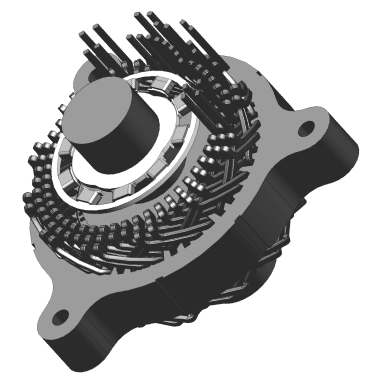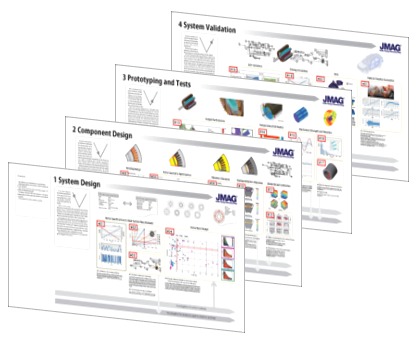Electric Vehicle
Using models to develop traction motors
With the advancement of EV components, traction motors, in particular, are expected to exert high product performance in terms of low power consumption, high efficiency, high output, low vibration and noise, small size, and low cost. In addition to the performance of the motor alone, it is also necessary to satisfy the requirements and consistency of the inverters, ECU, gearboxes, etc. at the system level and JMAG contributes to the design and verification of these requirements.
One of the requirements for EV traction motors is to achieve high efficiency throughout the entire traction range of the motor in a limited development period. This type of design requires defining many design variables including dimensions and drive conditions, in addition to selecting a motor type. Furthermore, design exploration that extends over a range of individual design variables as wide as possible should be performed at high-speed. JMAG has actual machine level analysis accuracy required in global design exploration at the early design stage, in detailed design and in virtual prototyping and is capable of processing this sequence of design workflow at high-speed.
One of the requirements for EV traction motors is to achieve high efficiency throughout the entire traction range of the motor in a limited development period. This type of design requires defining many design variables including dimensions and drive conditions, in addition to selecting a motor type. Furthermore, design exploration that extends over a range of individual design variables as wide as possible should be performed at high-speed. JMAG has actual machine level analysis accuracy required in global design exploration at the early design stage, in detailed design and in virtual prototyping and is capable of processing this sequence of design workflow at high-speed.

Examples of development
The motor, a key component of electrification requires not only high performance but also high compatibility with the system.
Model-based development, that makes use of simulation is becoming essential in motor development.
JMAG, with a strong track record in motor design, proposes a new workflow for model-based development.
The case study shows the details of the actual process of EV motor development from system design, component design, prototyping and performance evaluation through to system verification.
Model-based development, that makes use of simulation is becoming essential in motor development.
JMAG, with a strong track record in motor design, proposes a new workflow for model-based development.
The case study shows the details of the actual process of EV motor development from system design, component design, prototyping and performance evaluation through to system verification.

Case study
Kensuke Sasaki, Nissan Motor Co., Ltd.
Makoto Kawaguchi, Mazda Motor Corporation
Takashi Kawaguchi, Honda Motor Co., Ltd.
Toshifumi Yamakawa, TOYOTA MOTOR CORPORATION
Yoshihisa Kubota, Honda R&D Co.,Ltd
Marin Vulic, Rimac Automobili d.o.o.
Bharadwaj Raghuraman/Shafigh Nategh, Volvo Car Corporation
Tomoya Ueda, NIDEC CORPORATION
Tim Schwartz / Sebastian Igel, Great Wall Motor Austria Research & Development GmbH
Jihyun Kim, General Motors
Sukhwa Jung, DENSO CORPORATION
Daniel Keller, Mercedes Benz AG
Hideto Hanada, TOYOTA MOTOR CORPORATION
David Philipp Morisco, Robert Bosch GmbH




